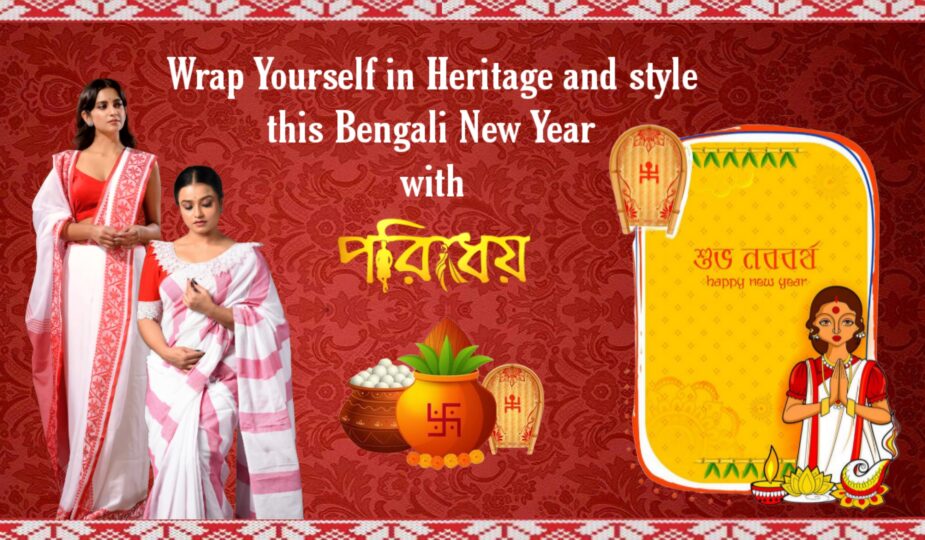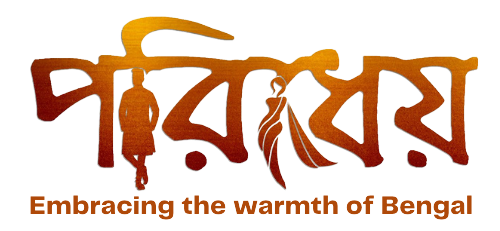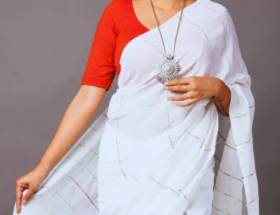
Poila Boishakh Saree from Poridheo: A Journey Through Time and Tradition
The Bengali New Year, known as Poila Boishakh, is not just a date on the calendar; it’s a celebration deeply rooted in tradition, culture, and heritage. And what better way to celebrate this auspicious occasion than by donning a gorgeous Poila Boishakh saree? Let’s take a trip through time and tradition as we explore the significance of Poila Boishakh sarees from Poridheo and how they have evolved over the years.

Introduction
Every year, as the calendar turns to April, Bengalis across the globe eagerly anticipate the arrival of Poila Boishakh, the Bengali New Year, which marks the beginning of a new year according to the Bengali calendar. One of the quintessential elements of this celebration is the attire, especially the Poila Boishakh saree, which encapsulates the essence of Bengali culture and heritage. It’s a time of joy, festivities, and new beginnings. Let’s delve deeper into the history, tradition, and evolution of these mesmerizing sarees that hold a special place in every Bengali’s heart.
Origins of Poila Boishakh Saree
The tradition of wearing sarees on Poila Boishakh dates back centuries. It reflects the rich cultural heritage of Bengal and symbolizes elegance, grace, and femininity. Initially, sarees were woven manually on handlooms, showcasing intricate designs and patterns. Over time, with advancements in technology, the art of saree-making has evolved, but its essence remains unchanged.
Evolution of Traditional Attire
Over the years, the Poila Boishakh saree has evolved, adapting to changing fashion trends while preserving its traditional charm; it’s a symbol of tradition and identity. Women adorn themselves in vibrant sarees, often in shades of red, white, or yellow, which signify prosperity and auspiciousness. You can pair traditional jewellery and accessories with the Poila Boishakh saree to complete the ensemble, adding a touch of elegance to the celebrations. Each saree tells a story of cultural evolution and artistic innovation, from handwoven fabrics to modern interpretations.
Poila Boishakh Saree
As Poila Boishakh approaches, the hunt for the perfect Poila Boishakh saree begins. With many options available, choosing the ideal Noborsho saree can be overwhelming. Consider factors like fabric, design, and colour to find a saree that complements your style and personality. Whether you opt for a traditional handloom saree or a contemporary designer saree, let your choice reflect your individuality and celebrate the spirit of Poila Boishakh in style. Embrace the spirit of the new year with a stunning saree that reflects your personality and heritage.
Types of Bengali Sarees
Bengali sarees come in many styles, each representing a distinct regional influence and craftsmanship. From the intricate Jamdani to the rustic elegance of Khadi, these sarees are a testament to the diversity of Bengali tradition.
Khadi: Symbol of Simplicity
Khadi sarees are unique in Bengali culture, symbolizing simplicity and elegance. Hand-spun and handwoven, they hold a special place in the hearts of Bengalis for their simplicity and elegance. Handwoven from natural fibres, their delicate texture and simple style make them highly prized. They are not just a fashion statement but also a tribute to the Khadi movement led by Mahatma Gandhi. Their timeless appeal and eco-friendly nature make them famous for Poila Boishakh celebrations.
Mulmul: Embracing Comfort
Mulmul sarees are perfect for those seeking comfort without compromising style and budget. Light, breathable, and adorned with delicate prints, Mulmul sarees exude a sense of effortless beauty, ideal for the festive season. These lightweight sarees come in many colours and designs, from traditional motifs to contemporary prints. Mulmul cotton sarees are prized for their soft texture and breathable fabric, making them ideal for the warm weather of Poila Boishakh. Embrace comfort and style with a Mulmul cotton saree that exudes effortless charm.
Jamdani: Weaving Stories
The exquisite muslin fabric and elaborate floral motifs handwoven by talented artisans are the hallmarks of Jamdani sarees. Originating from Dhaka, Bangladesh, Jamdani sarees have a rich history dating back to the Mughal era. Each saree is meticulously handwoven, with motifs that tell stories of love, nature, and mythology, making them cherished heirlooms for generations to come. Today, they are prized for their sheer elegance and craftsmanship, making them popular for special occasions like Poila Boishakh.
Handloom Revival: Sustainable Fashion
In an era of fast fashion, the revival of handloom sarees represents a shift towards sustainable and ethical fashion practices. The beautiful craftsmanship and elaborate designs of handloom sarees make them highly prized. Each saree is a work of art, showcasing the skill and creativity of the weavers. Handloom sarees from Poridheo promote cultural heritage and environmental conservation by supporting local artisans and preserving traditional weaving techniques. Whether the intricate motifs of Baluchari sarees or the subtle elegance of Taant sarees, handloom sarees continue to mesmerize with their timeless beauty.
Poridheo Heritage: Reviving Tradition
Poridheo, a renowned brand dedicated to preserving Bengali heritage, plays a pivotal role in reviving the tradition of Poila Boishakh sarees. With a focus on authenticity and craftsmanship, Poridheo sarees celebrate the timeless beauty of Bengali culture.
Styling Tips for Poila Boishakh Saree
Once you’ve chosen the perfect Poila Boishakh saree, it’s time to elevate your look with the proper styling. When styling your Poila Boishakh saree, embrace traditional jewellery such as Jhumkas, bangles, and necklaces to complement the intricate designs. Opt for minimalistic makeup adorned with fresh flowers for a touch of elegance and a classic hairstyle to let the saree take centre stage and make a lasting impression. And remember to add a hint of sindoor and bindi for a traditional Bengali touch.
Conclusion
Poila Boishakh sarees hold great cultural significance for Bengalis as we embark on this journey through time and tradition. From their humble beginnings to their evolution into timeless pieces of art, Poila Boishakh sarees continue to captivate with their beauty and grace. With their rich history, cultural significance, and artistic craftsmanship, they serve as a reminder of our heritage and identity. So, as you celebrate the Bengali New Year, embrace the tradition and adorn yourself with a stunning Poila Boishakh saree that reflects the essence of this auspicious occasion.
FAQs
Q1. Where can I purchase authentic Poila Boishakh saree?
You can purchase authentic Poila Boishakh sarees from renowned brands like Poridheo.
Q2. What makes Jamdani sarees unique?
Jamdani sarees are unique for their intricate handwoven motifs, often depicting stories from mythology and nature, making each saree a work of art.
Q3. Are Khadi sarees suitable for festive occasions?
Yes, Khadi sarees are suitable for festive occasions like Poila Boishakh due to their elegant simplicity and soft texture, which exude sophistication.
Q4. How can I support the handloom revival movement?
You can support the handloom revival movement by purchasing handloom sarees from Poridheo, promoting awareness about traditional weaving techniques, and advocating for policies that protect artisanal livelihoods.
Q5. Can Mulmul sarees be styled for formal events?
Yes, Mulmul sarees can be styled for formal events by pairing them with statement jewellery and accessories, such as metallic bangles or embroidered clutches, to elevate the look while maintaining comfort and elegance.
Q6. What is Poila Boishakh Saree?
The Poila Boishakh saree is a traditional Bengali attire worn during the celebration of the Bengali New Year. It symbolizes tradition, culture, and elegance.
Q7. What are some popular types of Poila Boishakh saree?
Cotton sarees made of Jamdani, Tant, Khadi, Baluchari, and Mulmul are a few popular styles of Poila Boishakh sarees.
Q8. How do I choose the right Noboborsho saree?
When choosing a Noboborsho saree, consider factors like fabric, design, and colour that complement your style and personality. Traditional handloom sarees and contemporary designer sarees are both excellent choices.
Q9. What accessories should I pair with my Poila Boishakh saree?
You can pair your Poila Boishakh saree with traditional jewellery like Jhumkas, bangles, and a statement necklace. Remember to add a hint of sindoor and bindi to add a conventional Bengali touch.
Embark on this journey through time and tradition as you celebrate Poila Boishakh in style, embracing the elegance and grace of the timeless Poila Boishakh saree.






